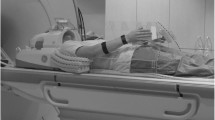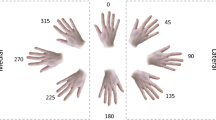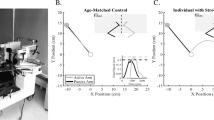Abstract
Somatosensation is frequently impaired in individuals with Cerebral Palsy (CP). This includes the sense of proprioception, which is an important contributor to activities of daily living. One means of determining proprioceptive deficits in CP has been use of an Ipsilateral Remembered (IR) position matching test. The IR test requires participants to replicate, without vision, memorized joint/limb positions previously experienced by the same (i.e. ipsilateral) effector. Given the memory component inherent to this task, the present study sought to determine the extent to which IR proprioceptive matching might be influenced by known spatial working memory deficits. Eleven adults with CP underwent IR elbow position matching, where blindfolded individuals were given either a short (2 s) or long (15 s) duration to memorize the target elbow angle. A standard clinical measure of spatial working memory (i.e. Corsi block-tapping task) was also administered. The results showed that the directional (i.e. constant) error produced across trials did not differ between the short and long target duration conditions. However, it was found that participants were significantly more consistent in their matches (i.e. had smaller variable errors) when given more time to encode proprioceptive targets in the long duration condition. The benefit of having more time was greatest for those individuals with the highest variable errors in the short target condition, and a significant association was seen between improvements in variable error and greater performance on 4/5 spatial working memory measures. These findings provide the best evidence to date that IR position matching tests are influenced by spatial working memory.




Similar content being viewed by others
References
Adamo DE, Martin BJ, Brown SH (2007) Age-related differences in upper limb proprioceptive acuity. Percept Mot Skills 104:1297–1309
Adamo DE, Alexander NB, Brown SH (2009) The influence of age and physical activity on upper limb proprioceptive ability. J Aging Phys Act 17:272–293
Adamovich SV, Berkinblit MB, Hening W, Sage J, Poizner H (2001) The interaction of visual and proprioceptive inputs in pointing to actual and remembered targets in Parkinson’s disease. Neuroscience 104:1027–1041
Arnould C, Penta M, Thonnard JL (2007) Hand impairments and their relationship with manual ability in children with cerebral palsy. J Rehabil Med 39:708–714
Bohannon RW, Smith MB (1987) Interrater reliability of a modified Ashworth scale of muscle spasticity. Phys Ther 67:206–207
Chrysagis NK, Skordilis EK, Koutsouki D, Evans E (2007) Kinesthetic ability in children with spastic hemiplegia. Adapt Phys Activ Q 24:332–351
Cooper J, Majnemer A, Rosenblatt B, Birnbaum R (1995) The determination of sensory deficits in children with hemiplegic cerebral palsy. J Child Neurol 10:300–309
Corsi PM (1972) Human memory and the medial temporal region of the brain. McGill University, Montreal
Dubois B, Pillon C (1997) Cognitive deficits in Parkinson’s disease. J Neurol 244:2–8
Eliasson AC, Krumlinde-Sundholm L, Rosblad B, Beckung E, Arner M, Ohrvall AM, Rosenbaum P (2006) The manual ability classification system (MACS) for children with cerebral palsy: scale development and evidence of validity and reliability. Dev Med Child Neurol 48:549–554
Folkerth RD (2005) Neuropathologic substrate of cerebral palsy. J Child Neurol 20:940–949
Gagliardi C, Tavano A, Turconi AC, Pozzoli U, Borgatti R (2011) Sequence learning in cerebral palsy. Pediatr Neurol 44:207–213
Goble DJ (2010) Proprioceptive acuity assessment via joint position matching: from basic science to general practice. Phys Ther 90:1176–1184
Goble DJ, Brown SH (2007) Task-dependent asymmetries in the utilization of proprioceptive feedback for goal-directed movement. Exp Brain Res 180:693–704
Goble DJ, Brown SH (2008) Upper limb asymmetries in the matching of proprioceptive versus visual targets. J Neurophysiol 99:3063–3074
Goble DJ, Brown SH (2009) Dynamic proprioceptive target matching behavior in the upper limb: effects of speed, task difficulty and arm/hemisphere asymmetries. Behav Brain Res 200:7–14
Goble DJ, Lewis CA, Hurvitz EA, Brown SH (2005) Development of upper limb proprioceptive accuracy in children and adolescents. Hum Mov Sci 24:155–170
Goble DJ, Hurvitz EA, Brown SH (2009a) Deficits in the ability to use proprioceptive feedback in children with hemiplegic cerebral palsy. Int J Rehabil Res 32:267–269
Goble DJ, Noble BC, Brown SH (2009b) Proprioceptive target matching asymmetries in left-handed individuals. Exp Brain Res 197:403–408
Goble DJ, Noble BC, Brown SH (2010) Where was my arm again? Memory-based matching of proprioceptive targets is enhanced by increased target presentation time. Neurosci Lett 481:54–58
Goble DJ, Coxon JP, Van Impe A, Geurts M, Doumas M, Wenderoth N, Swinnen SP (2011) Brain activity during ankle proprioceptive stimulation predicts balance performance in young and older adults. J Neurosci 31:16344–16352
Goble DJ, Coxon JP, Van Impe A, Geurts M, Van Hecke W, Sunaert S, Wenderoth N, Swinnen SP (2012a) The neural basis of central proprioceptive processing in older versus younger adults: an important sensory role for right putamen. Hum Brain Mapp 33:895–908
Goble DJ, Mousigian MA, Brown SH (2012b) Compromised encoding of proprioceptively determined joint angles in older adults: the role of working memory and attentional load. Exp Brain Res 216:35–40
Hohman LB, Baker L, Reed R (1958) Sensory disturbances in children with infantile hemiplegia, triplegia, and quadriplegia. Am J Phys Med 37:1–6
Iachini I, Iavorone A, Senese VP, Ruotolo F, Ruggiero G (2009) Visuospatial memory in healthy elderly, AD and MCI: a review. Curr Aging Sci 2:43–59
Inder TE, Huppi PS, Warfield S, Kikinis R, Zientara GP, Barnes PD, Jolesz F, Volpe JJ (1999) Periventricular white matter injury in the premature infant is followed by reduced cerebral cortical gray matter volume at term. Ann Neurol 46:755–760
Jenks KM, de Moor J, van Lieshout EC, Maathuis KG, Keus I, Gorter JW (2007) The effect of cerebral palsy on arithmetic accuracy is mediated by working memory, intelligence, early numeracy, and instruction time. Dev Neuropsychol 32:861–879
Jenks KM, de Moor J, van Lieshout EC (2009) Arithmetic difficulties in children with cerebral palsy are related to executive function and working memory. J Child Psychol Psychiatry 50:824–833
Jones B (1976) The perception of passive joint-movements by cerebral-palsied children. Dev Med Child Neurol 18:25–30
Jones SA, Henriques DY (2010) Memory for proprioceptive and multisensory targets is partially coded relative to gaze. Neuropsychologia 48:3782–3792
Jones SA, Fiehler K, Henriques DY (2012) A task-dependent effect of memory and hand-target on proprioceptive localization. Neuropsychologia 50:1462–1470
Kenney WE (1963) Certain sensory defects in cerebral palsy. Clin Orthop Relat Res 27:193–195
Keogh JM, Badawi N (2006) The origins of cerebral palsy. Curr Opin Neurol 19:129–134
Kessels RP, van Zandvoort MJ, Postma A, Kappelle LJ, de Haan EH (2000) The Corsi block-tapping task: standardization and normative data. Appl Neuropsychol 7:252–258
Klingels K, De Cock P, Molenaers G, Desloovere K, Huenaerts C, Jaspers E, Feys H (2010) Upper limb motor and sensory impairments in children with hemiplegic cerebral palsy. Can they be measured reliably? Disabil Rehabil 32:409–416
Krumlinde-Sundholm L, Eliasson AC (2002) Comparing tests of tactile sensibility: aspects relevant to testing children with spastic hemiplegia. Dev Med Child Neurol 44:604–612
Kurz MJ, Wilson TW (2011) Neuromagnetic activity in the somatosensory cortices of children with cerebral palsy. Neurosci Lett 490:1–5
Leonard G, Milner B (1991a) Contribution of the right frontal lobe to the encoding and recall of kinesthetic distance information. Neuropsychologia 29:47–58
Leonard G, Milner B (1991b) Recall of the end-position of examiner-defined arm movements by patients with frontal- or temporal-lobe lesions. Neuropsychologia 29:629–640
Leonard G, Milner B (1995) Recall of self-generated arm movements by patients with unilateral cortical excisions. Neuropsychologia 33:611–622
Monaco M, Cost A, Caltagirone C, Carlesimo GA (in press) Forward and backward span for verbal and visuo-spatial data: standardization and normative data from an Italian adult population. Neurol Sci. doi:10.1007/s10072-012-1150-x
Nagae LM, Hoon AH Jr, Stashinko E, Lin D, Zhang W, Levey E, Wakana S, Jiang H, Leite CC, Lucato LT, van Zijl PC, Johnston MV, Mori S (2007) Diffusion tensor imaging in children with periventricular leukomalacia: variability of injuries to white matter tracts. AJNR Am J Neuroradiol 28:1213–1222
Naito E, Roland PE, Grefkes C, Choi HJ, Eickhoff S, Geyer S, Zilles K, Ehrsson HH (2005) Dominance of the right hemisphere and role of area 2 in human kinesthesia. J Neurophysiol 93:1020–1034
Naito E, Nakashima T, Kito T, Aramaki Y, Okada T, Sadato N (2007) Human limb-specific and non-limb-specific brain representations during kinesthetic illusory movements of the upper and lower extremities. Eur J Neurosci 25:3476–3487
Odding E, Roebroeck ME, Stam HJ (2006) The epidemiology of cerebral palsy: incidence, impairments and risk factors. Disabil Rehabil 28:183–191
Oldfield RC (1971) The assessment and analysis of handedness: the Edinburgh inventory. Neuropsychologia 9:97–113
Opila-Lehman J, Short MA, Trombly CA (1985) Kinesthetic recall of children with athetoid and spastic cerebral palsy and of non-handicapped children. Dev Med Child Neurol 27:223–230
Palisano R, Rosenbaum P, Walter S, Russell D, Wood E, Galuppi B (1997) Development and reliability of a system to classify gross motor function in children with cerebral palsy. Dev Med Child Neurol 39:214–223
Poizner H, Fookson OI, Berkinblit MB, Hening W, Feldman G, Adamovich S (1998) Pointing to remembered targets in 3-D space in Parkinson’s disease. Mot Control 2:251–277
Rameckers EA, Smits-Engelsman BC, Duysens J (2005) Children with spastic hemiplegia are equally able as controls in maintaining a precise percentage of maximum force without visually monitoring their performance. Neuropsychologia 43:1938–1945
Rothwell JC, Traub MM, Day BL, Obeso JA, Thomas PK, Marsden CD (1982) Manual motor performance in a deafferented man. Brain 105(Pt 3):515–542
Sainburg RL, Ghilardi MF, Poizner H, Ghez C (1995) Control of limb dynamics in normal subjects and patients without proprioception. J Neurophysiol 73:820–835
Sanger TD, Kukke SN (2007) Abnormalities of tactile sensory function in children with dystonic and diplegic cerebral palsy. J Child Neurol 22:289–293
Shultz RW, Roy EA (1973) Absolute error: the devil in disguise. J Mot Behav 5:141–153
Smits-Engelsman BC, Rameckers EA, Duysens J (2005) Muscle force generation and force control of finger movements in children with spastic hemiplegia during isometric tasks. Dev Med Child Neurol 47:337–342
Smorenburg AR, Ledebt A, Deconinck FJ, Savelsbergh GJ (2011) Visual feedback of the non-moving limb improves active joint-position sense of the impaired limb in spastic hemiparetic cerebral palsy. Res Dev Disabil 32:1107–1116
Smorenburg AR, Ledebt A, Deconinck FJ, Savelsbergh GJ (2012) Deficits in upper limb position sense of children with spastic hemiparetic cerebral palsy are distance-dependent. Res Dev Disabil 33:971–981
Tachdjian MO, Minear WL (1958) Sensory disturbances in the hands of children with cerebral palsy. J Bone Joint Surg Am 40-A:85–90
Tardieu G, Tardieu C, Lespargot A, Roby A, Bret MD (1984) Can vibration-induced illusions be used as a muscle perception test for normal and cerebral-palsied children? Dev Med Child Neurol 26:449–456
Tizard JP, Crothers B (1952) Sensory disturbances in hemiplegia in childhood. Trans Am Neurol Assoc 56:227–229
Twitchell TE (1966) Sensation and the motor deficit in cerebral palsy. Clin Orthop Relat Res 46:55–61
Van Heest AE, House J, Putnam M (1993) Sensibility deficiencies in the hands of children with spastic hemiplegia. J Hand Surg Am 18:278–281
van Roon D, Steenbergen B, Meulenbroek RG (2005) Movement-accuracy control in tetraparetic cerebral palsy: effects of removing visual information of the moving limb. Mot Control 9:372–394
Vercher JL, Sares F, Blouin J, Bourdin C, Gauthier G (2003) Role of sensory information in updating internal models of the effector during arm tracking. Prog Brain Res 142:203–222
Wann JP (1991) The integrity of visual-proprioceptive mapping in cerebral palsy. Neuropsychologia 29:1095–1106
Wechsler D (1981) WAIS-R manual. Psychological Corporation, New York
Wilde NJ, Strauss E, Tulsky DS (2004) Memory span on the Wechsler scales. J Clin Exp Neuropsychol 26:539–549
Wilson ET, Wong J, Gribble PL (2010) Mapping proprioception across a 2D horizontal workspace. PLoS ONE 5:e11851
Wingert JR, Burton H, Sinclair RJ, Brunstrom JE, Damiano DL (2009) Joint-position sense and kinesthesia in cerebral palsy. Arch Phys Med Rehabil 90:447–453
Yeargin-Allsopp M, Van Naarden Braun K, Doernberg NS, Benedict RE, Kirby RS, Durkin MS (2008) Prevalence of cerebral palsy in 8-year-old children in three areas of the United States in 2002: a multisite collaboration. Pediatrics 121:547–554
Yekutiel M, Jariwala M, Stretch P (1994) Sensory deficit in the hands of children with cerebral palsy: a new look at assessment and prevalence. Dev Med Child Neurol 36:619–624
Acknowledgments
Special thanks to Susan Brown for use of the Motor Control Laboratory in the School of Kinesiology at the University of Michigan. This work was supported, in part, by a fellowship award to D. Goble by the Canadian Institutes for Health Research—Institutes for Aging.
Author information
Authors and Affiliations
Corresponding author
Rights and permissions
About this article
Cite this article
Goble, D.J., Aaron, M.B., Warschausky, S. et al. The influence of spatial working memory on ipsilateral remembered proprioceptive matching in adults with cerebral palsy. Exp Brain Res 223, 259–269 (2012). https://doi.org/10.1007/s00221-012-3256-8
Received:
Accepted:
Published:
Issue Date:
DOI: https://doi.org/10.1007/s00221-012-3256-8




